A Project of the Hudson River Estuary Program
Compiled by Tom Lake, Consulting Naturalist
COVID-19 Guidance for Enjoying the Outdoors
While enjoying outdoor spaces, please continue to follow the CDC/NYSDOH guidelines for preventing the spread of colds, flu, and COVID-19. To find out more about enjoying DEC lands and New York's State Parks, visit DEC's website Play Smart*Play Safe*Play Local; https://www.dec.ny.gov/outdoor/119881.html
Keep at least six (6) feet of distance between you and others.
Wear a cloth face covering in public settings where social distancing measures are difficult to maintain.
Avoid close contact, such as shaking hands, hugging, and kissing.
Wash hands often or use a hand sanitizer when soap and water are not available.
Avoid surfaces that are touched often, such as doorknobs, handrails, and playground equipment.
DEC recommends avoiding busy trailheads. Find the trails less traveled and visit when trails may not be as busy during daylight hours.
Overview
This week’s highlight is less of a high point and more of an ecological concern. For about a month, Almanac readers and contributors have been reporting large numbers of dead and dying Atlantic menhaden in the tidewater Hudson River and adjacent waters, covering nearly 100 miles from Haverstraw Bay to Long Island Sound. Atlantic menhaden (Brevoortia tyrannus) is a saltwater herring that also uses the brackish water reach of the estuary at different points in its life. The cause of the mortality is presently unknown. Samples have been collected by NYSDEC and are currently being analyzed by several labs.
Highlight of the Week
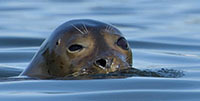 11/29 – Saugerties, HRM 102: In mid-morning, our resident seal (his longevity has earned him residency) popped his head up next to the Saugerties Lighthouse. This was Day 486 for the male harbor seal in Esopus Creek and the Hudson River around the lighthouse (since August 21, 2019). (Photo of harbor seal courtesy of Linda Napolitano) 11/29 – Saugerties, HRM 102: In mid-morning, our resident seal (his longevity has earned him residency) popped his head up next to the Saugerties Lighthouse. This was Day 486 for the male harbor seal in Esopus Creek and the Hudson River around the lighthouse (since August 21, 2019). (Photo of harbor seal courtesy of Linda Napolitano)
- Patrick Landewe
Natural History Entries
11/28 – Hook Mountain, HRM 31: On our 2020 season-ender, we counted four migrating raptors at the Hook Mountain Hawkwatch today; red-shouldered hawk was high count with three. The other raptor was a sharp-shinned hawk.
- Felicia Napier, Steve Sachs
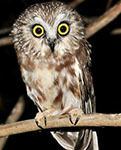 11/28 – Mea culpa from last week’s Hudson River Almanac included two saw-whet owl updates: 11/28 – Mea culpa from last week’s Hudson River Almanac included two saw-whet owl updates:
- The first was gender confusion (the sex of the owl). When the Christmas Tree at Rockefeller Center gave up its saw-whet owl last week, initial determination had it as an adult male. However, once at Ravensbeard Nature Center in Saugerties for rehabilitation, it was discovered that the saw-whet owl was a female.
- Also, we described the saw-whet as the smallest owl in North America. And, while the northern saw-whet owl is unquestionably tiny (8-inches-high), she was no higher (smaller) than fourth place on the Tiny Owl List. The smallest is the elf owl (Micrathene whitneyi), at 5.75-inches, followed by both the northern pygmy-owl (Glaucidium gnoma) and the ferruginous pygmy-owl (G. basilianum), both at 6.75-inches-high. (Photo of saw whet owl courtesy of Scott Somershoe)
11/28 – Green Island, HRM 153: We watched an ominous wall of clouds approach, black as night, spanning from the western horizon to overhead—and then came the hail. A sharp and bitter wind accompanied the BB-sized hail stones as we covered up in our oilskins. In thirty minutes, the front had passed to the east and the sun came out. There was a smattering of common mergansers, both hens and drakes, on the river at the head of tide. Two adult bald eagles perched like book ends, one on the Troy side, the other on the Green Island side. This was likely the adult pair from nearby bald eagle nest NY101.
- Tom Lake, T.R. Jackson
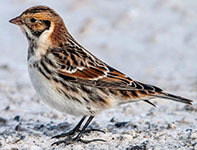 11/28 – Croton Point, HRM 44: My early morning walk around the landfill was rewarded with a close look at a flock of Lapland longspurs. After a minute, they flushed, and a male Cooper’s hawk flew in over the crest of a hill flying low to the ground. The hawk chased the flock to the edge of the landfill and then gave up and perched in a mulberry tree. (Photo of Lapland longspur courtesy of Andrew Simon) 11/28 – Croton Point, HRM 44: My early morning walk around the landfill was rewarded with a close look at a flock of Lapland longspurs. After a minute, they flushed, and a male Cooper’s hawk flew in over the crest of a hill flying low to the ground. The hawk chased the flock to the edge of the landfill and then gave up and perched in a mulberry tree. (Photo of Lapland longspur courtesy of Andrew Simon)
- Christopher Letts
11/28 – Hook Mountain, HRM 31: We counted 28 migrating raptors at the Hook Mountain Hawkwatch today including an adult golden eagle; red-tailed hawk led with twelve. Vultures (turkey 70, black 6) led among non-raptor migrants. The golden eagle came right along the south side of the summit. It started from far below, scaring multiple vultures high, and then climbed far up into the bottom of low clouds, setting its wings, and moving quickly southwest.
- Tom Fiore, Kristine Wallstrom
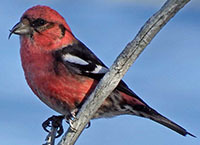 11/29 – Stillwater, HRM 171.5: It was mid-morning on our drive through the Saratoga National Historical Park when we came upon two dozen red crossbills foraging in the pines at the pull-off that precedes Stop number 7. (Photo of red crossbill courtesy of Bob Duchesne) 11/29 – Stillwater, HRM 171.5: It was mid-morning on our drive through the Saratoga National Historical Park when we came upon two dozen red crossbills foraging in the pines at the pull-off that precedes Stop number 7. (Photo of red crossbill courtesy of Bob Duchesne)
- Rita Reed (Hudson-Mohawk Bird Club)
 11/29 – Saugerties, HRM 102: A short-tailed weasel was spotted on the rocks at low tide around the Saugerties Lighthouse at first light. It was wearing its splendid white winter coat, the short-tailed weasel’s ermine phase. (Photo of short-tailed weasel courtesy of Les Piccolo) 11/29 – Saugerties, HRM 102: A short-tailed weasel was spotted on the rocks at low tide around the Saugerties Lighthouse at first light. It was wearing its splendid white winter coat, the short-tailed weasel’s ermine phase. (Photo of short-tailed weasel courtesy of Les Piccolo)
- Patrick Landewe
[The short-tailed weasel’s (Mustela erminea) fur becomes white in the circumpolar northern winter as an adaptation for concealment in a season of snow and in the presence of predators. Tom Lake]
 11/30 – Ulster County, HRM 81: We were working under our porch today in some soft, often trampled dirt, frequently eroded from gully-washer rains, when we came upon what appeared to be a stone artifact. It was a small stone (45 x 25 millimeters (mm)) that showed definite shaping by a human tool maker. We have lots of rock in our yard since we live at the base of the Shawangunk Ridge, and we often scan for “ancient treasures” since it’s something that interests both of us. (Photo of kanawha point courtesy of Karina Reets) 11/30 – Ulster County, HRM 81: We were working under our porch today in some soft, often trampled dirt, frequently eroded from gully-washer rains, when we came upon what appeared to be a stone artifact. It was a small stone (45 x 25 millimeters (mm)) that showed definite shaping by a human tool maker. We have lots of rock in our yard since we live at the base of the Shawangunk Ridge, and we often scan for “ancient treasures” since it’s something that interests both of us. (Photo of kanawha point courtesy of Karina Reets)
- Aaron Reets, Karina Reets
(One inch = 25.4 millimeters (mm))
[The bilateral percussion flaking on Karina’s stone artifact indicated that it was a genuine artifact. More specifically, it was a projectile point, a stone tool used as a spear point, a tip on a dart, or as a knife. The point appeared to have been fashioned from local rock (gray chert) obtained from a regional quarry (this was the Stone Age) probably in Greene County.
Our first pass on identification suggested that it was an eared-notched or bifurcated point. By broadening our imagination, non-unlike like finding a picture in a picture, we recognized attributes of a roughly made point that we call a Kanawha or a Hardaway. It was an ancient mini treasure. The Reets’ house was built in 1966, and it is likely that there was significant displacement of dirt that turned the soil stratigraphy upside down.
These points are uncommon but not rare in the Hudson Valley. When we investigated excavations at Clinton Point (Dutchess County) a decade ago, we recovered four Kanahwa and one Hardaway point that we stylistically dated 8200-8300 years old. The artisans of these points were hunters and gatherers, fishers and foragers, in an age well before ceramics (pottery), horticulture, village life, and the bow-and arrow. We do not know much about them, their names, even their tribal names. We know them only by the artifacts they leave behind and the stories that have been passed on to their descendants. We theorize that these were the long-ago ancestors of the Algonquian-speakers, Munsee and Mohican Indians, that were met by the first Europeans more than six-thousand years later.
It is magical to be able to hold in your hand a moment of the past, to touch a piece of the deep time of the Hudson Valley and wonder who made it and what their world was like eight millennia ago. Tom Lake]
 12/1 – Saugerties, HRM 102: A guest at the Saugerties Lighthouse was able to get a few photos of the ermine that we first saw just a couple of days ago. The handsome and very cooperative short-tailed weasel climbed up on the deck of the lighthouse for us to see. (Photo of short-tailed weasel courtesy of David Bober) 12/1 – Saugerties, HRM 102: A guest at the Saugerties Lighthouse was able to get a few photos of the ermine that we first saw just a couple of days ago. The handsome and very cooperative short-tailed weasel climbed up on the deck of the lighthouse for us to see. (Photo of short-tailed weasel courtesy of David Bober)
- Patrick Landewe
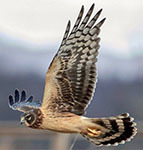 12/1 – New Paltz, HRM 78: My young children and I are always exploring the woods and watching the skies. Today, we spotted two adult bald eagles around the flooded corn fields along the Wallkill River. One of them flew over the shallow flood waters in front of us making four or five passes. Perhaps it had spotted a duck or a small mammal. The other eagle perched in a tree along the river, its white head glowing in the sunshine. A northern harrier cruised low just over a grassy area, hunting. All of them may have been taking a break in their migration south. (Photo of northern harrier courtesy of Debbie Quick) 12/1 – New Paltz, HRM 78: My young children and I are always exploring the woods and watching the skies. Today, we spotted two adult bald eagles around the flooded corn fields along the Wallkill River. One of them flew over the shallow flood waters in front of us making four or five passes. Perhaps it had spotted a duck or a small mammal. The other eagle perched in a tree along the river, its white head glowing in the sunshine. A northern harrier cruised low just over a grassy area, hunting. All of them may have been taking a break in their migration south. (Photo of northern harrier courtesy of Debbie Quick)
- Sven Jenkins
12/1 – Bedford, HRM 35: The final red-shouldered hawk total for 2020, our 43rd season, at the Bedford Audubon Chestnut Ridge Hawkwatch was 802, a new record. Our previous high count was 499 in 2013.
This was our 43rd season. The observation point for the Hawkwatch at Chestnut Ridge is at an elevation of about 770 feet, with a 180-degree view oriented to the east. Birders have been observing migrating raptors from Chestnut Ridge since at least 1978.
- Tait Johansson
12/1 – Beacon, HRM 61: Dark gray clouds were gathering on the western horizon and moving east with the aid of a cold west wind. Behind the clouds came sunshine and a cold front. Earlier, the full moon spring tide with a strong west wind had pushed the river up and into the Long Dock parking lot. We waited for the start of the ebb, and then set our seine at the top of the tide as the wind, now quartering to the southwest, sent sand-filled rollers up on the beach. Each haul found only banded killifish (55-75 mm). The river was still bearably cool at 51 degrees Fahrenheit (F), and the salinity was steady measurable at 1.0 part-per-thousand (ppt).
- Tom Lake, A. Danforth
12/2 – Hudson River Watershed: As a service to birders and Christmas Bird Count coordinators, the New York State Ornithological Association maintains an easy-to-use, one-page online calendar of New York State Christmas Bird Counts: http://nybirds.org/ProjCBC.html
- Carena Pooth (Ralph T. Waterman Bird Club)
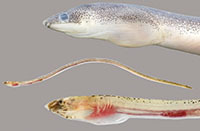 12/2 – Hudson River Watershed: Fish-of-the-Week for Week 99 is the speckled worm eel (Myrophis punctatus), number 21 (of 234) on our watershed list of fishes. If you would like a copy of our list, e-mail - trlake7@aol.com. 12/2 – Hudson River Watershed: Fish-of-the-Week for Week 99 is the speckled worm eel (Myrophis punctatus), number 21 (of 234) on our watershed list of fishes. If you would like a copy of our list, e-mail - trlake7@aol.com.
The speckled worm eel is a snake eel in the family Ophichthidae. They are found in tropical marine and brackish water habitats from the Carolinas throughout the Caribbean to Brazil. Adults are a secretive, benthic, burrowing fish that can reach thirteen inches in length. They are classified as a tropical marine stray in our area.
The speckled worm eel was added to the Hudson River Fish Fauna List in 1984 from an immature (226 mm) taken by a fisheries consultant’s bottom trawl in the Upper Bay of New York Harbor. A second immature (176 mm) was collected in 1991 in the Arthur Kill.
The paucity of species available for study from New York waters does not necessarily indicate that this species is rare here. Speckled worm eel is difficult to catch in conventional sampling gear because it spends much time burrowed in bottom sediments and its small size makes it difficult to retain in netting (Schmidt 2018). (Photo of speckled worm eel courtesy of Zachary Randell)
- Tom Lake
12/3 – Minerva, HRM 284: I was out hiking today with three other folks on an old dirt road that runs down to the Hudson River within the Town of Minerva. It was 40 degrees F with mostly sunny conditions. Deer Creek runs to the west along this road (Fourteenth Road). We had a half-inch of snow and a tad of dusting left in the woods. We didn't run into any critters, but the mosses and evergreen ferns were beautiful, Christmas fern and spinulose woodfern in particular. It was a great hike.
- Mike Corey
[Mike’s hike has me thinking of scents of the season. I have half-a-mind to drive 200 miles north to Essex County just so I can hike in the forest and get intoxicated on the fragrance of balsam fir. Tom Lake]
12/3 – Manhattan, New York City: Randall’s Island Park Alliance Staff spotted a great egret and great blue heron today at the boat launch along the Bronx Kill (northwest corner of the Island). I wonder if this is the great blue heron that spent its winter with us last year.
- Jackie Wu
[Most great blue herons migrate once it becomes apparent that open water is disappearing. A few, however, will stick out the winter especially in the New York City area where open tidewater persists except during the very coldest winters. They are also very adept at improvisation.
Several years ago, at Lake Meahagh in Verplanck (Westchester County), a sudden winter cold snap caused a massive gizzard shad fish kill and laid down two inches of hard ice. The image of hundreds of ten-inch gizzard shad floating just under the clear ice attracted bald eagles from all over. But the fish were out of reach; the eagles did not have the equipment to get through the ice. But a pair of great blue herons sauntered out from a stand of Phragmites and drilled through the ice exposing the fish. Each time that occurred, an eagle would swoop down and steal the gizzard shad. Undaunted by the eagles, this scenario was repeated from mid-morning until dusk, when the herons departed, leaving Pete Nye, Chris Letts and me with a story to tell. Tom Lake]

Fall 2020 Natural History Programs
Natural History Programs sponsored by the Livingston Free Library: Join us for thirty-minute presentations on Turtles, Climate Change, Invasive Species, and more followed by Q&A, presented by Naturalist Chelsea Moore of the NYSDEC Hudson River Estuary Program, offered every other Wednesday to the Livingston Library at 11:00 AM and to the Starr Library at 4:00 PM.
Winter trees (photosynthesis)
Wednesday, December 16, 2020 11:00 AM and 4:00 PM
Registration for Starr, e-mail: Daniel@starrlibrary.org
Registration for http://livingston.lib.ny.us/ or Livingstonlibrary105@gmail.com
Wednesday, December 16, 2020 11:00 AM
"Wetland Conservation: What Do We Have to Lose?"
This presentation is part of the Capital District Regional Planning Commission's Fall Webinar Series. Laura Heady, NYSDEC Hudson River Estuary Program, will provide an introduction to the diversity of Hudson Valley wetlands and the benefits they provide for clean water, wildlife, and climate adaptation. This webinar is designed to bring wetlands to life and expand our understanding of their complexity and value to our communities. Municipal approaches to wetland conservation will also be discussed.
Registration is required; visit CDRPC fall webinar series Eventbrite for more information contact Laura Heady laura.heady@dec.ny.gov
Wednesday, December 16 from 7:00-8:00 PM
Conserving Habitats & Wildlife on the Rensselaer Plateau
Zoom - https://www.rensselaerplateau.org/lecture-registration
This lecture will introduce priority habitats and wildlife of conservation concern on the Rensselaer Plateau, maps and resources for learning more, and basic conservation strategies. Learn about what we have, what’s most vulnerable, and what we can do about it.
Information: Ingrid Haeckel ingrid.haeckel@dec.ny.gov
Friday, December 18, 2020 from 1:30-3:30 PM
Implementation of Nature-based Shoreline Projects: Initiatives since 2015 in New York State: A Sustainable Shorelines Webinar
This webinar will cover the efforts on nature-based shoreline protection in New York State since 2015, including work on the implementation of the Community Risk and Resilience Act, as well as projects in the Hudson River, the Great Lakes, the Niagara River, and Long Island Sound.
For More Information and to Register: https://www.hrnerr.org/estuary-training/trainingtopic/sustainableshorelines-designs-webinar-series
Day in the Life of the Hudson and Harbor
October 22, 2020 was this year’s Day in the Life of the Hudson and Harbor. Videos and data sheets are available below and on DEC’s Day in the Life of the Hudson and Harbor website. Teachers may schedule a distance learning program for their classes or discuss the video lessons with an Estuary educator by contacting hrteach@dec.ny.gov.
• New York Harbor and Connected Waterways
NY Harbor Data Sheet (PDF)
• Lower Estuary: Yonkers to Beacon/Newburgh
Lower Estuary Data Sheet (PDF)
• Upper Estuary: Poughkeepsie to Peebles Island
Upper Estuary Data Sheet (PDF)
The Estuary Live! (Hudson River Estuary Program)
Our environmental education programs are broad, varied, flexible, and dependent on the needs and interests of your students. These distance-learning programs can last anywhere from 30 minutes to an hour and are available on ZOOM, Google classrooms, or Webex platforms. Pre-program materials from our Virtual River content include videos and lesson plans for students to explore before their Estuary Live! program. Students are encouraged to ask questions which creates an interactive learning environment, rather than a lecture. Estuary Live! is often hosted from an outdoor location but is dependent on the weather and cell service. The Norrie Point Environmental Center has three indoor sets (The Library, The Lab, and The Classroom) that allow us to stay connected during lessons and give students a feeling of being here with us.
Program types and a brief description of the topics:
Wildlife (e.g., amphibians, turtles, and fish)
Hudson River basics, e.g. geography, tides, salinity, turbidity, temperature, basic ecology.
Climate change
American Eels
Stream Study: macroinvertebrates, e.g., adaptations, habitat, and human impact.
Educators can schedule a program for their students:
https://docs.google.com/forms/d/e/1FAIpQLScr6Sidcq70JL3xLvubH1J-WfAkRMsR6AWvUtHsdcOiUvXrcw/viewform
Contact Maija Lisa Niemistö email:maija.niemisto@dec.ny.gov
Follow Us On-Line:
Check out our wonderful Tide Finder video (3 minutes) with Chris Bowser marking the extreme highs and lows of a full moon tidal cycle: Tide Finder video
Virtual River website: Virtual River Website
Hudson River Miles
The Hudson is measured north from Hudson River Mile 0 at the Battery at the southern tip of Manhattan. The George Washington Bridge is at HRM 12, the Tappan Zee 28, Bear Mountain 47, Beacon-Newburgh 62, Mid-Hudson 75, Kingston-Rhinecliff 95, Rip Van Winkle 114, and the Federal Dam at Troy, the head of tidewater, at 153. The tidal section of the Hudson constitutes a bit less than half the total distance – 315 miles – from Lake Tear of the Clouds to the Battery. Entries from points east and west in the watershed reference the corresponding river mile on the mainstem.
To Contribute Your Observations or to Subscribe
The Hudson River Almanac is compiled and edited by Tom Lake and emailed weekly by DEC's Hudson River Estuary Program. Share your observations by e-mailing them to trlake7@aol.com. To subscribe to the Almanac (or to unsubscribe), use the links on DEC's Hudson River Almanac or DEC Delivers web pages.
Discover New York State
The Conservationist, the award-winning, advertisement-free magazine focusing on New York State's great outdoors and natural resources. The Conservationist features stunning photography, informative articles and around-the-state coverage. Visit The Conservationist webpage for more information.
Useful Links
National Oceanic and Atmospheric Administration online tide and tidal current predictions are invaluable when planning Hudson River field trips. For real-time information on Hudson River tides, weather and water conditions from sixteen monitoring stations, visit the Hudson River Environmental Conditions Observing System website.
DEC's Smartphone app for iPhone and Android is now available at: New York Fishing, Hunting & Wildlife App.
PLAY SMART * PLAY SAFE * PLAY LOCAL: Get Outside Safely, Responsibly, and Locally
New York State is encouraging residents to engage in responsible recreation during the ongoing COVID-19 public health crisis. NYSDEC and State Parks recommendations for getting outside safely incorporate guidance from the Centers for Disease Control and Prevention and the NYS Department of Health for reducing the spread of infectious diseases.
DEC and State Parks are encouraging visitors to New York's great outdoors to use the hashtags #PlaySmartPlaySafePlayLocal, #RecreateResponsibly, and #RecreateLocal on Facebook, Twitter, and Instagram to share their visit and encourage others to get outside safely, responsibly, and locally, too. Use the DECinfo Locator to find a DEC-managed resource near you and visit the State Parks website for information about parks and park closures.
Take the Pledge to PLAY SMART * PLAY SAFE * PLAY LOCAL: Enjoy the Outdoors Safely and Responsibly
1. I pledge to respect the rules and do my part to keep parks, beaches, trails, boat launches, and other public spaces safe for everyone.
2. I will stay local and close to home.
3. I will maintain a safe distance from others outside of my household.
4. I will wear a mask when I cannot maintain social distancing.
5. I accept that this summer, I may have to adjust how I enjoy the outdoors to help keep myself and others healthy and safe, even if it means changing my plans to visit a public space.
6. I will be respectful of others by letting them pass by me if needed on a trail and keeping my blanket ten feet apart from others on the beach.
7. I will move quickly through shared areas like parking lots, trailheads, and scenic areas to avoid crowding.
8. If I'm not feeling well, I will stay home.
Information about the Hudson River Estuary Program is available on DEC's website at http://www.dec.ny.gov/lands/4920.html.
|


 11/29 – Saugerties, HRM 102: In mid-morning, our resident seal (his longevity has earned him residency) popped his head up next to the Saugerties Lighthouse. This was Day 486 for the male harbor seal in Esopus Creek and the Hudson River around the lighthouse (since August 21, 2019). (Photo of harbor seal courtesy of Linda Napolitano)
11/29 – Saugerties, HRM 102: In mid-morning, our resident seal (his longevity has earned him residency) popped his head up next to the Saugerties Lighthouse. This was Day 486 for the male harbor seal in Esopus Creek and the Hudson River around the lighthouse (since August 21, 2019). (Photo of harbor seal courtesy of Linda Napolitano) 11/28 – Mea culpa from last week’s Hudson River Almanac included two saw-whet owl updates:
11/28 – Mea culpa from last week’s Hudson River Almanac included two saw-whet owl updates:  11/28 – Croton Point, HRM 44: My early morning walk around the landfill was rewarded with a close look at a flock of Lapland longspurs. After a minute, they flushed, and a male Cooper’s hawk flew in over the crest of a hill flying low to the ground. The hawk chased the flock to the edge of the landfill and then gave up and perched in a mulberry tree. (Photo of Lapland longspur courtesy of Andrew Simon)
11/28 – Croton Point, HRM 44: My early morning walk around the landfill was rewarded with a close look at a flock of Lapland longspurs. After a minute, they flushed, and a male Cooper’s hawk flew in over the crest of a hill flying low to the ground. The hawk chased the flock to the edge of the landfill and then gave up and perched in a mulberry tree. (Photo of Lapland longspur courtesy of Andrew Simon) 11/29 – Stillwater, HRM 171.5: It was mid-morning on our drive through the Saratoga National Historical Park when we came upon two dozen red crossbills foraging in the pines at the pull-off that precedes Stop number 7. (Photo of red crossbill courtesy of Bob Duchesne)
11/29 – Stillwater, HRM 171.5: It was mid-morning on our drive through the Saratoga National Historical Park when we came upon two dozen red crossbills foraging in the pines at the pull-off that precedes Stop number 7. (Photo of red crossbill courtesy of Bob Duchesne) 11/29 – Saugerties, HRM 102: A short-tailed weasel was spotted on the rocks at low tide around the Saugerties Lighthouse at first light. It was wearing its splendid white winter coat, the short-tailed weasel’s ermine phase. (Photo of short-tailed weasel courtesy of Les Piccolo)
11/29 – Saugerties, HRM 102: A short-tailed weasel was spotted on the rocks at low tide around the Saugerties Lighthouse at first light. It was wearing its splendid white winter coat, the short-tailed weasel’s ermine phase. (Photo of short-tailed weasel courtesy of Les Piccolo) 11/30 – Ulster County, HRM 81: We were working under our porch today in some soft, often trampled dirt, frequently eroded from gully-washer rains, when we came upon what appeared to be a stone artifact. It was a small stone (45 x 25 millimeters (mm)) that showed definite shaping by a human tool maker. We have lots of rock in our yard since we live at the base of the Shawangunk Ridge, and we often scan for “ancient treasures” since it’s something that interests both of us. (Photo of kanawha point courtesy of Karina Reets)
11/30 – Ulster County, HRM 81: We were working under our porch today in some soft, often trampled dirt, frequently eroded from gully-washer rains, when we came upon what appeared to be a stone artifact. It was a small stone (45 x 25 millimeters (mm)) that showed definite shaping by a human tool maker. We have lots of rock in our yard since we live at the base of the Shawangunk Ridge, and we often scan for “ancient treasures” since it’s something that interests both of us. (Photo of kanawha point courtesy of Karina Reets) 12/1 – Saugerties, HRM 102: A guest at the Saugerties Lighthouse was able to get a few photos of the ermine that we first saw just a couple of days ago. The handsome and very cooperative short-tailed weasel climbed up on the deck of the lighthouse for us to see. (Photo of short-tailed weasel courtesy of David Bober)
12/1 – Saugerties, HRM 102: A guest at the Saugerties Lighthouse was able to get a few photos of the ermine that we first saw just a couple of days ago. The handsome and very cooperative short-tailed weasel climbed up on the deck of the lighthouse for us to see. (Photo of short-tailed weasel courtesy of David Bober) 12/1 – New Paltz, HRM 78: My young children and I are always exploring the woods and watching the skies. Today, we spotted two adult bald eagles around the flooded corn fields along the Wallkill River. One of them flew over the shallow flood waters in front of us making four or five passes. Perhaps it had spotted a duck or a small mammal. The other eagle perched in a tree along the river, its white head glowing in the sunshine. A northern harrier cruised low just over a grassy area, hunting. All of them may have been taking a break in their migration south. (Photo of northern harrier courtesy of Debbie Quick)
12/1 – New Paltz, HRM 78: My young children and I are always exploring the woods and watching the skies. Today, we spotted two adult bald eagles around the flooded corn fields along the Wallkill River. One of them flew over the shallow flood waters in front of us making four or five passes. Perhaps it had spotted a duck or a small mammal. The other eagle perched in a tree along the river, its white head glowing in the sunshine. A northern harrier cruised low just over a grassy area, hunting. All of them may have been taking a break in their migration south. (Photo of northern harrier courtesy of Debbie Quick) 12/2 – Hudson River Watershed: Fish-of-the-Week for Week 99 is the speckled worm eel (Myrophis punctatus), number 21 (of 234) on our watershed list of fishes. If you would like a copy of our list, e-mail -
12/2 – Hudson River Watershed: Fish-of-the-Week for Week 99 is the speckled worm eel (Myrophis punctatus), number 21 (of 234) on our watershed list of fishes. If you would like a copy of our list, e-mail - 